Featured
Former Mixed Doubles Slam Champion and Author Gordon Forbes Passes Away Due to Covid-19
The South African is the third champion mourned by fans in a few days, following Dennis Ralston and Alex Olmedo. What follows is a tribute written by a close friend and one-time opponent, Joseph B. Stahl.
Published
4 years agoon
By
Staff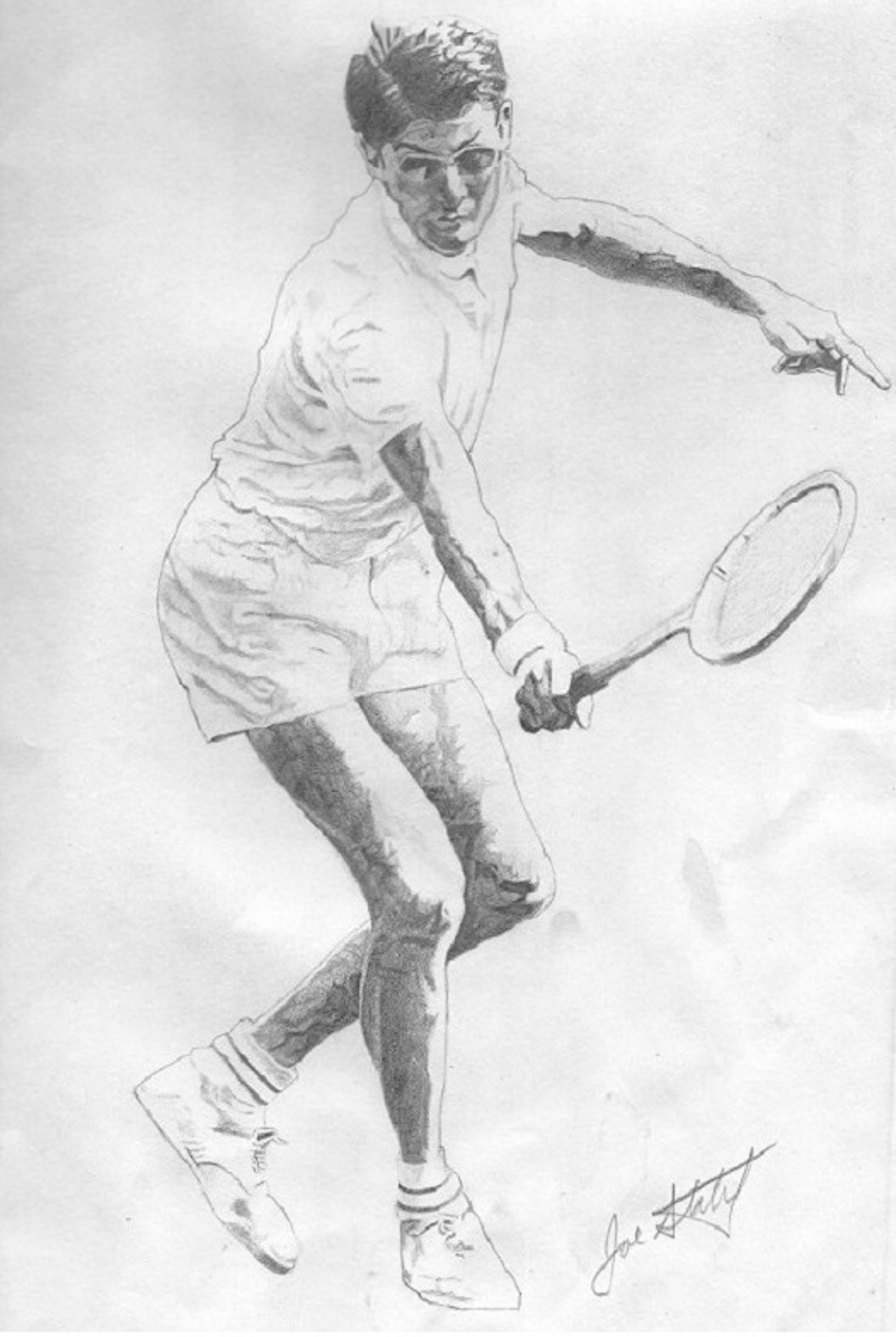
Forbes died on December 9, at age 86. He won the 1955 French Open (partnering Darlene Hard) and reached another final at Roland Garros in 1963, this time in the men’s doubles partnering Abe Segal, his long-time on-court companion. After retiring, he wrote several books, including “A handful of summer” and “Too soon too panic”, published in 1979 and 1995, respectively. In 1959, Ubitennis founder Ubaldo Scanagatta was on scoreboard duty as a teenager during the Davis Cup tie between Italy and South Africa in which Forbes played both singles and doubles. What follows is a rememberance written by Gordon’s friend Joseph B. Stahl (also the author of the drawing above), whereas here can be found the tributes to Ralston and Olmedo.
Gordon L. Forbes of South Africa, an Inadequate Memoir of a Master Raconteur and a Helluva Tennis Player by Joe Stahl
I first met Gordon in August 1962 when we both played in the grasscourt Meadow Club Invitational Tennis Tournament at Southampton, Long Island, N.Y.; it was a lead-in event to the U.S. Nationals at Forest Hills. I really wasn’t good enough to be in that tournament, but somehow Grenville Walker, who ran it, let me in the draw. I was paired against Gordon in the first round and really had no idea who he was, although he’d reached the third round at Wimbledon only a few weeks earlier.
On the morning of the Monday on which the tournament began, I was practicing on the Meadow Club’s grass with Arthur Ashe when Arthur called me to the net and, pointing to a tall fellow three courts down the way, told me, “That’s your first-round opponent.” Gordon was practicing with a skinny kid who looked like Gordon had taken him out of his pocket and unfolded him; it was Cliff Drysdale.
Gordon didn’t look like much to me—mind you, I didn’t think I could beat him, but I thought we’d have a reasonably competitive match. Unfortunately, however, I made the dreadful mistake of practicing so long and so hard with Arthur the whole morning (at one point Arthur told me, “If your forehand were as good as your backhand, you’d be great”—you see, it was the one day a year that I could hit a backhand), that by the time my match with Gordon began that afternoon I was exhausted, and Gordon beat me -love and -love.
The diminutive but very famous New York Times tennis reporter Allison Danzig was in the stands—he had come all the way out to Southampton from Manhattan to cover the match—, and I remember his withdrawing a small notebook from his pocket when it began, but after only a few games, he put it back into his pocket and never took it out again. As Gordon and I shook hands at the net at the end of the match, I said to him, “Damn, Gord-o, I thought you were a gentleman. Don’t you know that a gentleman always lets an overmatched opponent win at least a courtesy game? It’s like it says in the Bible, never punish a man with more than 40 stripes ‘lest thy brother seem vile in thy sight.’ ”
Gordon thought reflectively for a moment and in one of those great philosophical inspirations he often had, he gently instructed me, “Joseph, that is all very well for religion, but tennis is different: In tennis it is a law that you should always beat your opponent as badly as you can.” And that generously imparted wisdom was the beginning of a friendship that lasted for decades.
We corresponded after that, and in 1979 when I read his book A Handful of Summers, I saw that, in it, he claimed he had lost in the first round of that Meadow Club Tournament in 1962 to Roger Werksman—not beaten me!—because he’d just gotten off an international airline flight at JFK Airport and driven all the way out to Southampton and was tired. So I sat down and wrote Gordon a letter on my legal stationery (I conducted a long masquerade as an attorney at law, 1963-2004) in which I told him I was going to file a wrongful-death lawsuit against him for prematurely canceling me out of existence, and I enclosed a copy of the Meadow Club draw showing that he’d beaten me in the first round, “6-0, 6-0.” I ended the letter, however, by telling him that all would be forgiven if he would buy me a drink whenever we might meet at Wimbledon, this was agreed between us, and for a long time he would invite me into the Last Eight Club at Wimbledon every year, “Gord-o” would buy me a drink, and we would have a lot of amusing chit-chat with the other characters hanging around in the Last Eight.
At the time I read his book, I was so taken with the comedy, the charm and the sense of it that I decided to buy seven copies of it to distribute to friends as Christmas presents. At that time, Russell Seymour, who had played on the South African Davis Cup team with Gordon, was the tennis professional at the New Orleans Lawn Tennis Club, and I asked Russell where I could find copies of the book. He told me that Gordon’s sister Jean, who lived in Texas, had a supply of them, he gave me her phone number and address, and after speaking with her by phone, I sent her a check and she sent me the seven books accompanied by a charmingly reminiscent letter about tennis people we both knew.

It was so shortly after that, only a day or so, that the news broke that Jean had died, that I thought her letter to me might be the last one she’d ever written, so, after photocopying it, I sent the original to Gordon in South Africa, knowing he would like to have it. Gordon’s second book, Too Soon to Panic, which of course I also read, was really an extended letter to Jean in her afterlife, and not long after its publication, Radio Wimbledon, the All England Club’s radio station for which I worked as a commentator, interviewer and talk-show participant, asked me to interview Gordon about the book, which I did. It is one of the best interviews I ever conducted, because I knew Gordon so well from his books and from personal acquaintance, so I knew what cues to give him to enable him to say everything he wanted to air.
Another incident about A Handful of Summers comes to mind. In, oh I guess, about the mid-1980s, I was visiting a doctor friend in Miami who took me on his hospital rounds with him one day. As we were navigating the hospital’s halls, a doctor stopped us and told my friend that if he wanted to see the most gorgeous collection of women ever assembled, to go to such-and-such a room, because there was an endless procession of beauties constantly coming there to visit a particular patient. So we went, and the patient turned out to be the French tennis player Jean-Noël Grinda, who was there for a coronary angioplasty.
None of the fabled women were there, but I asked Jean-Noël if he had read Gordon’s book A Handful of Summers, at which he groaned and said, “Ohhh, I have terrible memories of Gordon Forbes!” “Why is that?”, I asked him. “Because,” he said, “Gordon beat me 7-5 in the fifth set at Bournemouth one year after I led him 5-1, 40-15 in that set.” So I told him, “Listen, I am going to send you this book Gordon has written, and I swear that when you read it, you will actually like Gordon Forbes.”
The upshot of it was that I sent Jean-Noël the book at the French address he gave me, and Jean-Noël wrote back to me telling me he enjoyed the book and appreciated my sending it to him so much that he was reconciled to Gordon, and Jean-Noël invited me to stay at the Hotel Westminster Concorde on the Promenade des Anglais in Nice, which Jean-Noël owned, any time I wanted, for free. Alas, I never had a chance to take him up on it, but that is a tribute to how good the book is.
One thing that struck people about Gordon, not least me, was that he never seemed to age. Decades would go by, yet Gordon still looked exactly the same as he always had. One day in 1989 I was playing tennis at Lew Hoad’s Campo de Tenis on the Costa del Sol in Spain with Heather Brewer Segal, who had been married to Gordon’s doubles partner Abe Segal. Gordon at that time was in his mid-50s. Well, the subject of Gordon came up, and Heather said, “You know something, it just isn’t fair! Gordon still looks like he’s 28 years old!” And it was true. I told Heather, “Maybe he read The Picture of Dorian Gray, and he has a portrait of himself growing old for him in an attic.”
Lew Hoad sold Gordon’s Handful book in the shop at the Campo de Tenis, and Lew used to pontificate that it was, as Lew put it in his Australian lilt, “the grytist book on tinnis evah writtin.”
Of course the real hero of Gordon’s Handful is Abe Segal, the Abe Segal, that is, that Gordon portrayed him to be, an author of zany antics who was constantly poking fun at the foibles of mankind. And that portrayal is a testimonial to how creative Gordon could be. For the “Abie,” as Gordon always referred to him, of that book is more a figment of Gordon’s lively imagination than an authentic representation of the real Abe Segal. I say that because Abie published a memoir in 2008 called Hey, Big Boy! that destroyed the entire marvelous impression of him Gordon had created in Handful. Hey, Big Boy! is so terribly written in such atrociously illiterate English and reveals Abie to be such a clumsy oaf of a character, that I wrote to Gordon telling him this and how disappointed I was in Abie’s book. Gordon, who at that point did not even know Abie had written a book, wrote back to me lamenting that “He just had to have a book.” Had Abie not written that book, he would have lived forever as the grand Falstaffian hero Gordon had painted him as.
One of Gordon’s greatest bravura performances of wit was the after-dinner speech he gave at the annual pre-Wimbledon International Lawn Tennis Club of Great Britain Ball—“the IC Ball”—at the Dorchester Hotel in London, I guess in about the mid-1990s. Gordon’s talk was so loaded with his cleverness and hilarious witticisms, tempered by his wry take on the humor of things, and it delighted his audience, including me, so much that when he stopped talking I wanted to cry because I wanted him to continue talking forever. From the moment he spoke his first sentence he had people laughing in hysterics, he was so funny, and I wished I had said the things he came up with. It was the champagne and caviar of entertainment.
But besides being a sage observer of and reporter on life, Gordon was also a helluva tennis player, for he did have wins over Hoad, Laver and Drobny.
I have a bad habit of making pictures of things that strike my fancy, and in 1962 I did a pencil drawing of Gordon from a photo of him that appeared in World Tennis magazine that shows Gordon hitting a backhand. When I showed the drawing to Russell Seymour, he took one look at it and said, “That’s Forbsey’s backhand alright.” Here it is:
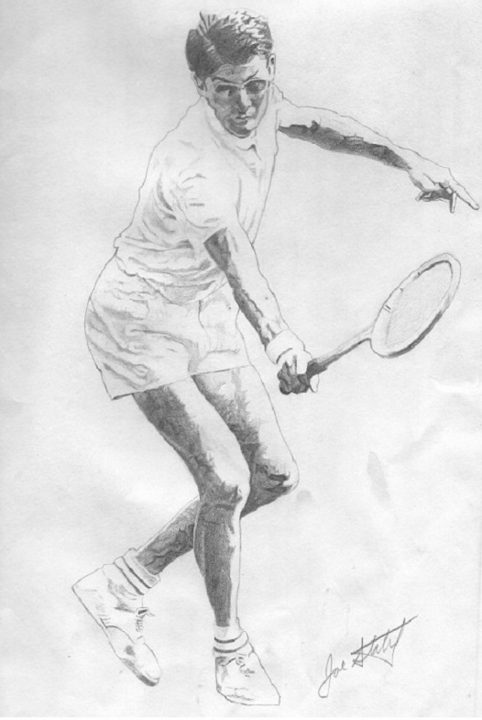
Joe Stahl, by his own confession, masqueraded as an attorney at law for 41 years, retiring in 2004, since which, he has done three things very badly: write; paint; and play tennis. He is hoping to get into the Tennis Hall of Fame as the worst player in the history of the sport. He and Gordon Forbes were friends for many years, exchanging good-natured insults the whole time. Joe was a commentator at Wimbledon and an editor and contributor at Tennis Week magazine.
You may like
Featured
EXCLUSIVE: The Grand Slam Champion Who Didn’t Get A Trophy Until 37 Years After He Died
Published
8 months agoon
14/12/2023
This year’s French Open was headlined by Iga Swiatek and Novak Djokovic triumphing in the singles tournaments but at the same time, another trophy presentation took place.
Attended by only a handful of people which included Henri Leconte and Hungarian Olympic swimming champion Daniel Gyurta, the event was conducted in honor of József Asboth. A Hungarian tennis player who in 1947 became the first Eastern European player to win a Grand Slam title at the French Open. Asboth also reached the semi-finals of Wimbledon in 1948 which is remarkably still the best-ever performance by a Hungarian man at the event.
Sadly, he never received a trophy for his French Open triumph as the tournament didn’t start that tradition until 1981. However, this year the FFT made a silver plaque in his honour with the words ‘in memory of Jozsef Asboth, Vainqueur Simple Homme, Internationaux de France 1947.‘ The gesture occurred almost 40 years after he died in 1986.
Accepting the award was Andras Ruszanov on behalf of the Asboth family. He acts as an ambassador for the tennis star and his sporting legacy. Speaking to Ubitennis, Ruszanov sheds light on Asboth’s story which he described as being marred by history, politics and bad luck. As a player, he was only allowed to leave Hungary on the condition he didn’t defect to another country. One extraordinary example was when King Gustav V of Sweden helped persuade the Hungarian regime to let him play at Wimbledon in one year.
During the late 1940s and early 1950s, Asboth was restricted from travelling to Western countries and was also prohibited from going into business with Fred Perry who offered him a job. Instead, he was instructed to coach in the Soviet Union until the fall of his regime in 1956. Eventually, he went to Belgium to with work with the national tennis federation before going to Munich, Germany. He refused to return home until Soviet troops left his country which unfortunately didn’t happen until after he passed away at the age of 69.
Here is the story of Hungary’s first and only Grand Slam champion in men’s tennis.
UBITENNIS: How did the trophy ceremony in Paris come about this year? Was it triggered by a campaign?
RUSZANOV: I have been representing the Asbóth family for about 10 years. From the very first moment, I was always guided by the goal of preserving for posterity the memory of Hungary’s first and so far only male singles Grand Slam champion. This could be the name of a tournament, street, stadium, award or even a website named after the legendary champion, such as asbothjozsef.hu, which we created in tribute to him with photos from the family archive.
On the occasion of the 100th anniversary of the birth of József Asbóth (1917- 2017), Monika Seles presented the commemorative plaque of the Hungarian Tennis Federation and Hungarian Sports Journalist Association.
In 1947, the French Open winner received no recognition other than a congratulatory handshake. From 1981 the Musketeers’ Cup was awarded to the champions after the suggestion of the late Philippe Chatrier, the president of the French and International Tennis Federation. In 2017, the idea arose that some symbolic version of the Musketeers’ Cup could serve as an eternal memory for both the Asbóth family and the Hungarian sports society to nurture and preserve József Asbóth and his sports legacy.
Both the former and current leadership of the Hungarian Tennis Federation felt the weight and importance of this mission, and the request was heard by the leadership of the French Tennis Federation – led by President Gilles Moretton. Thus, at this year’s Roland Garros, during a private ceremony in the president’s box, in the presence of President Moretton and some French legendary players such as Henri Leconte, Patrick Proisy, and the showman Mansour Bahrami, I was able to receive the award on behalf of the Asbóth family from the two-time Grand Slam champion, Hall of Famer Amélie Mauresmo, who serves as the tournament director of French Open. The Hungarian sports diplomacy was represented by the Olympic champion Dániel Gyurta on behalf of the Hungarian Minister of Foreign Affairs, and the sports media was represented by György Szöllősi, vice president of AIPS Europe (European Sports Journalists Association).
This current recognition was the ‘fruit’ of several years of work, and the silver plaque that has just been handed over has the Musketeer’s Cup for the men’s singles champion in engraved form.
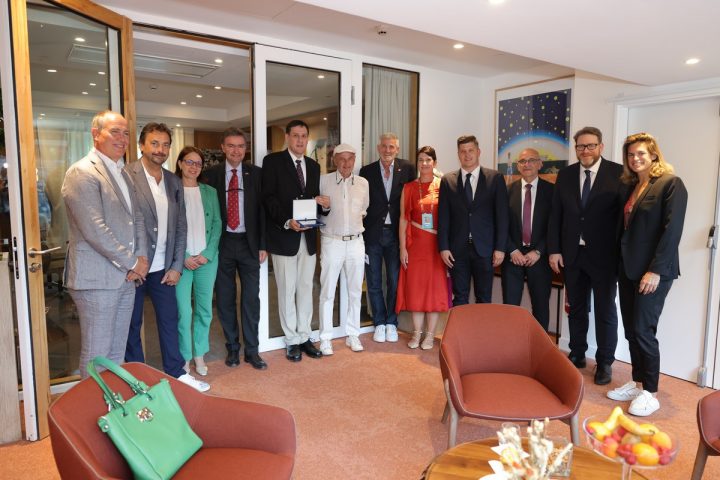
UBITENNIS: Was it true that Jozsef was only allowed to leave Hungary on a guarantee he would not defect to another country?
Yes, Asbóth’s entire career was cut in two by history, politics and bad luck. He played in a total of 10 Grand Slams, but 8 years passed between his 2nd and 3rd major. In his heyday – between the ages of 22 and 30 – he could not participate in a single Grand Slam, because of World War II and its consequences. Then he managed to win the 4th Grand Slam tournament of his life at the age of almost 30. Then the ordeals came again…
In 1948, Asbóth was seeded number 2 in Paris (which is still a record for a Hungarian male player) in the main draw. However, he could not defend his title, as his mother passed away the day before the start of the tournament, so Asbóth withdrew and flew home to Hungary.
His appearance at the next Slam, in Wimbledon, was also in jeopardy, as the communist leadership in his country did not look favourably on his performances in foreign tournaments. One of his great admirers, King Gustav V of Sweden had to give a personal guarantee to the Hungarian communist government that Asbóth would return to his country and not emigrate abroad. Thanks to the intervention of Sweden’s longest-reigning monarch, the Hungarian top player was able to attend Wimbledon and so far achieved the greatest success of a Hungarian male tennis player.
He reached the semi-final for the first time in Wimbledon and according to the unanimous opinion of the experts, Asbóth played the most spectacular tennis of all the players. He even captivated the legendary Harry Hopman, who patted Asbóth on the shoulder and said: “Listen here, mate, grass is your element”. Unfortunately, in the quarter-final match, Asbóth’s ankle was injured in such a way that the next day it was so swollen that he could barely walk, nonetheless, he played with all the more heart and energy (he lost the 2nd set 14-12!).
A healthy Asbóth would have had a real chance not only to reach the final but even to win the title. After his loss in the semi, despite the painful defeat and injury, he praised his opponent and did not make excuses!
Then the Communist Party leadership did not allow him to travel to Paris until 1954, and never to Australia or the States.
UBITENNIS: During the time of his playing career Hungary was going through oppression from the soviet union communist regime. How did he manage to cope with this?
RUSZANOV: Politics had an impact on his entire career, this is especially true for the years following World War II, to the beginning of communist rule, where they governed according to Stalinist practice. The economy was nationalized, and the communist rule serving the interests of the Soviet empire began in political life.
Asbóth and some of his fellow tennis players also took part in the post-war debris clean-up, and from the 1948s onwards, his travels to the West were restricted by the communist dictatorship. Instead of foreign tournaments, he was sent to Moscow to train and instruct Soviet coaches. But it also happened that the president of neighbouring Romania had to stand as the doubles partner of Petru Groza on the tennis court of the president’s private mansion, on a party order. And it happened that the president’s bodyguard was sitting in the chair umpire’s seat with a rifle in his hand.
Fred Perry, with whom he maintained an excellent friendship and whose clothing bearing his name appeared in 1952, offered Asbóth to join his company, but the Hungarian Communist Party did not agree to this.
After the defeat of the 1956 revolution, Asbóth retired from active play and accepted the invitation of the Belgian federation, or better said he could have accepted, since this also had to be approved by the party leadership. In Belgium, he became the head of the youth development program, and later he was asked to become head coach by the Iphitos tennis club in Munich.
He made a promise that he would not return to his country as long as Soviet troops were stationed in Hungary. Unfortunately, he could not live to see them leave, as he died on September 11, 1986, in Germany.
Embed from Getty ImagesUBITENNIS: How is his legacy viewed back home? Do many Hungarian players nowadays speak about him?
RUSZANOV: In Hungary, soccer is considered a national sport, and the legendary Ferenc Puskás, the captain of the national team known as the ‘Golden Magyar’ (unbeaten for 4 years in the 50s and beat England in the match of the century in 1953), is the best-known Hungarian athlete in the world and the FIFA Goal of the Year award also bears his name. The other fact is that in Hungary, the Olympic and World Championships are incredibly respected, so the names of the Olympic and World Champion athletes are almost always classified in the category of Hall of Fame in the country.
Unfortunately, József Asbóth was successful in an era when tennis did not enjoy such support, even though from the end of the 1940s the matches were played in front of a sold-out crowd. Largely thanks to József Asbóth, and Zsuzsa Körmöczy (1958 Roland Garros champion).
At the beginning of the 21st century, Asbóth’s successes have faded a bit, but on the one hand, with the appearance of the new Hungarian tennis generation, his name is being heard more and more. As the manager of the Asbóth sports legacy, I will do everything in my power to make his name known to as many Hungarians as possible.
Asbóth’s name inevitably always comes up, even in connection with Roland Garros or Wimbledon, because to this day he achieved the greatest individual success in Hungarian men’s tennis at these two Grand Slam events! I hope that this current recognition will also promote the renaissance of the Asbóth cult!
UBITENNIS: Are there any other stories of interest about him that you can share?
RUSZANOV: On July 6, 1938, in Budapest, after winning Wimbledon, Don Budge, who was on the European tour, and the then unknown 20-year-old Hungarian talent, József Asbóth, faced each other in an exhibition match. Asbóth played brilliantly and so well that American world number one gave up the match in the 3rd set with Asbóth’s lead, claiming that he had to catch the train to Prague. (At that time, Budge already won his 5th Grand Slam in a row, and a few weeks later he also triumphed at the US Open.)
József Asbóth has also a 1-0 H2H record against Roy Emerson, the male tennis player who has won the most Grand Slam titles of all time (16 singles and 12 doubles). Emerson played for the first time at Roland Garros at the age of 17, and in the first round, he faced the then almost 37-year-old Asbóth. Being a rookie from Australia, he did not know the former champion, ran into the dressing room and asked Ken Rosewall what he knew about Asbóth. Rosewall just said “I’m sorry” and held out his right hand and said “five fingers, that’s about how many games you’re going to win in three sets.”
When Emerson went out on the court before the match, he met an elegant gentleman in long pants. He thought he was the referee, so he introduced himself to him, to which he replied, “I’m József Asbóth”. During the warm-up, Asbóth did not foul a single ball and he played with so much feeling that his strokes almost spoke. Emerson sensed that he was in great trouble. The match began, and Asbóth toyed with the Australian as he wanted. He drove it from one side to the other, Emerson ran around like a chased wild animal. He was covered in sweat and grimy from head to toe, and Asbóth’s long pants didn’t even show a crease. Rosewall laughed himself to death in the stands. Emerson was in good shape, but after two sets he started to get very tired after Asbóth constantly controlled the game.
After the lost match Emerson asked who the hell is this guy? And Rosewall said, “Well, go out and look at the list of champions on the wall of the stadium”. Seeing that Asbóth won in 1947, Emerson didn’t feel so bad anymore.
UBITENNIS: Finally, what other tennis achievements did he produce outside of the Grand Slams?
RUSZANOV: Between April 1 and September 16, 1940, Asbóth participated in 11 tournaments, of which he won 9 (Genoa, Taormina, Palermo, Budapest, Wiesbaden, Gödöllő, Budapest, Milan and Merano).
In 1947, Asbóh participated in 12 tournaments, 3 domestic and 9 international best tournaments, of which he played in the final 8 times, of which he won 5 times (San Remo, Nice, Paris and twice in Budapest).
In 1948, he started in 11 competitions, and we find his name in 7 finals, of which he won the trophy 5 times. After Beaulieu, Cannes and Nice, he did not find a winner in Monte-Carlo (the predecessor of today’s Monte-Carlo Masters).
He won 24 matches in the Davis Cup and in 1949 he was able to play in the semifinals with the Hungarian team.
Among Asbóth’s mentors, we also find a name who is a defining figure in the history of tennis, one of the (perhaps the best) musketeers, the legendary Henri Cochet. The Hungarian player’s entire career was influenced by the French champion, which is why, like Cochet, he always wore a short-sleeved white shirt and long white pants throughout his career.
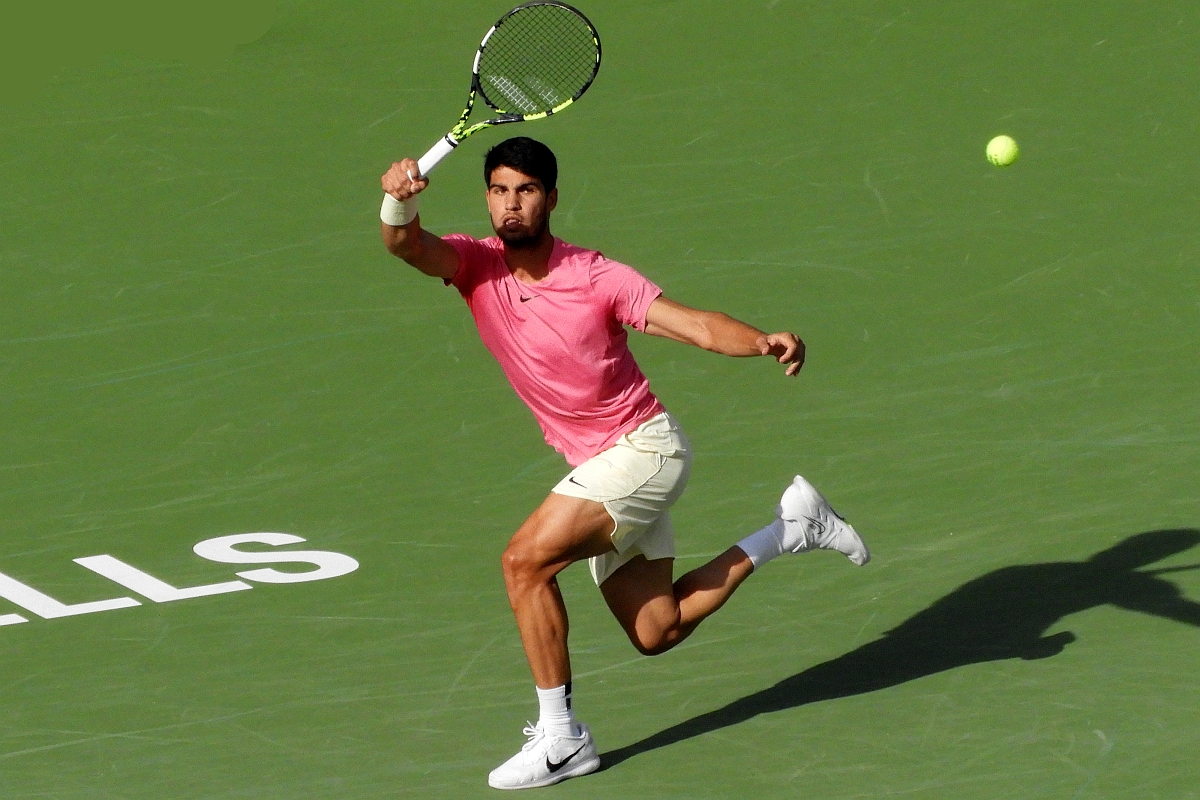
At this same time of the year in 2022, Carlos Alcaraz announced to the tennis community that he was ready to propel himself into the forefront of the sport. He reached the semifinals of the BNP Paribas Open at Indian Wells before losing to countryman Rafael Nadal amidst almost impossibly windy conditions in the California dessert. Although Alcaraz had already reached the quarterfinals of the 2021 U.S. Open, the stellar Indian Wells showing last year propelled him to another level.
In short order, Alcaraz won his first Masters 1000 title in Miami, captured another of those elite crowns in Madrid, and, at the end of last summer, took the U.S. Open title in New York. With that breakthrough triumph at a major, Alcaraz went to No. 1 in the world, and he concluded the season still stationed at the very top of tennis. He has been hobbled by injuries too often since last November and consequentially missed the Australian Open, but now this 19-year-old sensation is back on top of the world at No. 1 following a 6-3, 6-2 final round victory over Daniil Medvedev in the final at Indian Wells.
That was no mean feat for this strikingly mature champion. He is the youngest man ever to secure both the Miami and Indian Wells titles. Not since Roger Federer in 2017 had a male player taken this prestigious crown without losing a set. Medvedev was enjoying the second longest winning streak of his career of 19 match victories in a row. He was striving for a fourth consecutive ATP Tour title in a debilitating five-week span. He had seemingly almost forgotten how to lose after finding his form in Rotterdam in mid-February. He won there by toppling Jannik Sinner in the final. On he went to Doha, where he stopped Andy Murray in the final. The following week in Dubai, Medvedev ended a four match losing streak against Novak Djokovic with a 6-4, 6-4 semifinal win and then obliterated countryman Andrey Rublev 6-2, 6-2 in the title round.
Medvedev’s form fluctuated at Indian Wells but he seemed to be progressing as he headed into the final. But he had faced Alcaraz only once before. That was in 2021 at Wimbledon and Medvedev came through easily when Alcaraz was not the same player. So this collision at Indian Wells in the final was going to be revealing one way or another for two great players who figure to meet many more times on big occasions in the years ahead.
Some authorities believed Medvedev would exploit his experience, maintain his winning streak, and add another title to his collection. Of the 18 tournaments Medvedev has amassed starting in 2018, all but one have been on hard courts. But seldom has he been beaten as soundly as was by Alcaraz at Indian Wells. The Spaniard put 76% of his first serves in play compared to 65% for Medvedev. Alcaraz won 81% of his first serves points while Medvedev finished 20% behind his opponent in that department. Meanwhile, Alcaraz secured 58% of his second serve points and Medvedev finished well below that mark at 41%. Not once did Medvedev even reach break point. That is a rarity.
The humiliation for Medvedev transcended those facts. Time and again, Alcaraz set the tactical agenda. He caught Medvedev off guard with selective serve-and-volley combinations. He used the drop shot magnificently. He went for his shots freely and stayed away from the rhythmic long rallies on which Medvedev feasts. He kept Medvedev guessing for 70 painful minutes. For his part, Medvedev inexplicably attempted to match or surpass the Spaniard’s backcourt pace. He pressed off both sides. His forehand was well below par. And when Medvedev had the chance to prolong rallies and play more on his own terms, he impatiently went for bigger shots which backfired almost completely. His mind was muddled. Essentially and surprisingly, Medvedev was not ready to fight with his usual ferocity. He collapsed against an unrelenting Alcaraz.
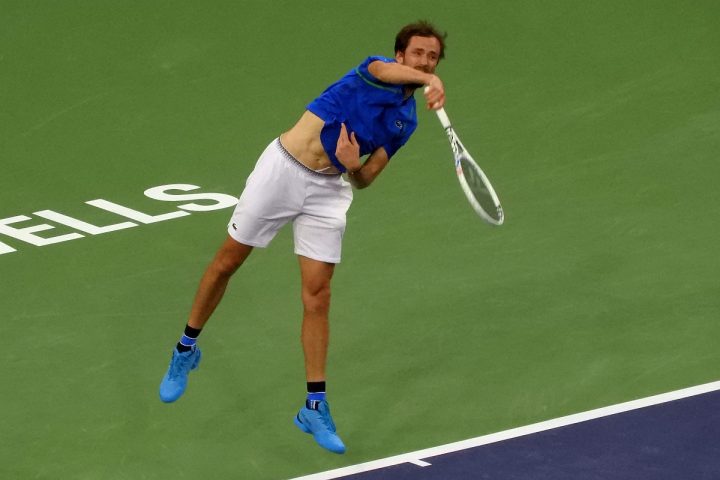
Alcaraz was primed from the outset. He raced to 3-0 in the opening set, sweeping 12 of 15 points on the process. Medvedev professionally started imposing himself and held serve three times after falling behind. In his last two service games he conceded only one point as he located his delivery more accurately. But Alcaraz was unswerving on his own delivery, winning 20 of 26 points in five service games. Serving for the set at 5-3, he held comfortably at 15, closing out that game by serve-volleying on the last two points.
Medvedev had seemingly found his bearings after a slow start, but Alcaraz pounced in the opening game of the second set and broke his dispirited opponent at love. Medvedev gave that game away with two unforced errors off the ground, an errant backhand volley and a double fault. Alcaraz swiftly held at love and moved ahead 0-30 on Medvedev’s serve in the third game. He had won ten points in a row.
Alcaraz went on to break Medvedev again for 3-0 and surged to 4-0 with another routine hold. It had taken him only 17 minutes to build that second set lead. The rest was a formality. Alcaraz closed out the account without stress despite being taken to deuce when he served for the match at 5-2.
That it all came down to a duel between Alcaraz and Medvedev— the last two U.S. Open champions—for the first Masters 1000 crown of 2023 made perfect sense. As an unvaccinated player, Novak Djokovic was not permitted to enter the United States to compete at Indian Wells and Miami. Rafael Nadal—three time champion at Indian Wells and runner-up to Taylor Fritz a year ago—was not ready to return to the ATP Tour after his latest injury that led to a second round loss at the Australian Open.
With the two icons absent, the cognoscenti of tennis hoped for an enticing final round confrontation between Alcaraz and Medvedev. The match did not come even close to delivering on its considerable promise, but the fact remained that they both deserved to be there. The beguiling Spaniard took apart the Australian Thanasi Kokkinakis 6-2, 6-3 in the second round, ousted the tall Dutchman Tallon Griekspoor 7-6 (4), 6-3 in the third round, and then needed less than 47 minutes to defeat an ailing Jack Draper of Great Britain. Alcaraz led 6-2, 2-0 in that clash when the left-hander was forced to retire.
Alcaraz was rolling now. He had lost all three of his previous appointments against the charismatic Felix Auger-Aliassime, who had improbably erased six match points against him in a round of 16 win over Tommy Paul. But this time around against FAA, Alcaraz was exhilarated under the lights and he came through comfortably 6-4, 6-4. The serving statistics from this encounter are telling. Alcaraz won 81% of his first serve points, which was 11% better than the Canadian. The Spaniard took a respectable 59% of his second serve points, while Auger-Aliassime stood far below at 42%.
Alcaraz was the superior performer across the board during this quarterfinal encounter. He was sounder and cagier, quicker and sprightlier. His return was first rate across the two sets, and he backed up his own delivery with uncanny efficiency. It was a confidence building triumph in every respect, and just what he needed as he headed into the semifinals to take on Jannik Sinner.
The Italian had overcome the defending champion Fritz in a sparkling quarterfinal skirmish lasting three absorbing sets. Sinner blasted away spectacularly against the Californian and he had the upper hand in the vast majority of long rallies contested on an exceedingly windy night.
Sinner is industrious, unwavering and often enterprising. He had been victorious in two of his four showdowns with Alcaraz, prevailing in a memorable four set, round of 16 clash on the Centre Court at Wimbledon last year before losing what may well have been the best tennis match in all of 2022 at the U.S. Open. In that quarterfinal confrontation under the lights in Arthur Ashe Stadium, Sinner had a match point in the fourth set of a pendulum swinging contest before Alcaraz rallied again from a break down to take the fifth set and prevail 6-3, 6-7 (7), 6-7 (0), 7-5, 6-3 in five hours and fifteen minutes of spellbinding tennis.
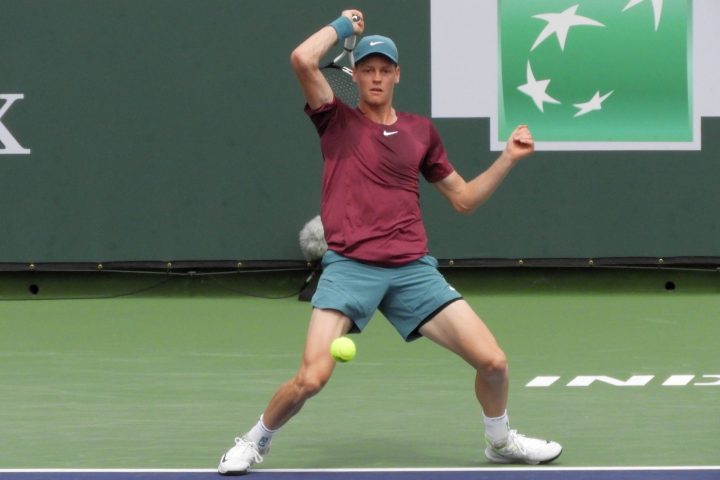
No wonder so many learned observers were looking forward to the fifth career collision between two players who will surely be taking prestigious prizes away from each other for the next decade. Alcaraz moved out in front 4-2 before Sinner took eleven points in a row (and 12 of 14) on his way to a 5-4 lead. Sinner needed that first set more than Alcaraz. The Italian reached 15-30 in the tenth game but narrowly missed a return. Alcaraz held on for 5-5 but soon faced a set point in the twelfth game. Sinner was right where he wanted to be, on the edge of a first set victory.
But Alcaraz is frequently at his best when faced with the sternest of challenges. He took a short blocked return from Sinner and released one of his patented drop shots. Sinner chased it down, but his passing shot was much too high. Alcaraz moved easily to his right and punched a forehand volley winner into the open court. The set would be settled in a tie-break, and Alcaraz was too good, breaking a 4-4 deadlock by sweeping three points in a row, sealing that sequence 7-4 with a scorching flat backhand winner crosscourt. Alcaraz made one break count in the second set and succeeded 7-6 (4), 6-3. It was a remarkable performance highlighting Alcaraz’s match playing acumen.
As for Medvedev, making it to the final was a much tougher task. He handled Brandon Nakashima 6-4, 6-3 in the second round, although the match was more competitive than the score would indicate. Then he overcame Ilya Ivashka 6-2, 3-6, 6-1 to reach the round of 16 and an eagerly awaited clash with Sascha Zverev.
Zverev has had a difficult time rediscovering the heights of his game after missing the second half of 2022 following the abysmal ankle injury he suffered against Nadal in the semifinals of Roland Garros. But he had started playing better tennis in Dubai a few weeks back before losing a semifinal to Andrey Rublev. Zverev largely outplayed Medvedev at Indian Wells but, three times over the course of the match, he squandered 0-40 openings. He also missed out on 15 of 17 break point opportunities.
On top of all that, Medvedev rolled his ankle in the middle of the second set and needed the trainer. Somehow he survived despite the injury, winning 6-7 (5), 7-6 (5), 7-5 despite getting broken at 5-4 in the final set when he served for the match the first time. Zverev then played horrendously at 5-5, double faulting on break point. Medvedev escaped.
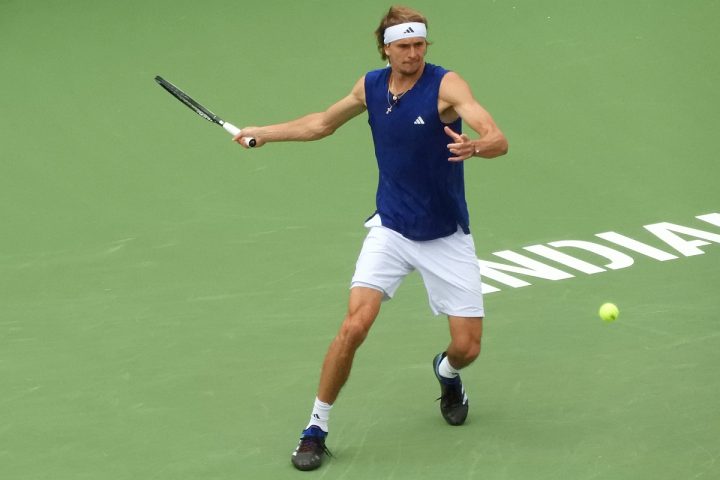
He remained concerned about the ankle in the quarterfinals against Alejandro Davidovich Fokina, and fell again, cutting his thumb in the process. Nevertheless, he got the win 7-5, 6-3. Two days off helped his cause considerably, and Medvedev looked fine physically on all fronts during his semifinal against Frances Tiafoe.
In fact, Medvedev was near the top of his game in establishing a 7-5, 5-3 lead. Seldom if ever has he produced so many breathtaking forehand passing shots, and, in turn, he was hardly missing from the baseline. But Tiafoe is doubly dangerous when he is behind, as he demonstrated so boldly last year in the U.S. Open semifinals against Alcaraz when he got up off the canvas after looking down and out to force a fifth set.
In this case, Tiafoe serve-volleyed his way out of two match points in the ninth game of the second set, and saved a third by provoking a forehand error on the stretch from Medvedev. Medvedev could not serve out the match at 5-4 but he broke right back at love in the eleventh game and served for the match a second time at 6-5. He reached 40-0 but Tiafoe erased four more match points in that astounding game. On they went to a tie-break, but an unruffled Medvedev did not fret. He took that sequence seven points to four, concluding the contest with a service winner and an ace. Medvedev was deservedly victorious 7-5, 7-6 (4). Not until he captured that match was his head cleared and his outlook altered. In the middle of the tournament, the 27-year-old was complaining vocally about the conditions, claiming that the slow conditions were not really hard court tennis as he knew it. That was a simple case of Medvedev irrationality.
A day later, Medvedev was trounced by a top of the line Alcaraz. He took the defeat graciously, recognizing that he had hit a physical and emotional wall after so much success in recent weeks. He also realized that Alcaraz had played a magnificent match. The Spaniard will be buoyed by the victory and confident that he has all the tools to confront Medvedev in the years to come. But Medvedev is a very studious fellow who will go back to the drawing board and examine what it will take to unsettle a surging Alcaraz the next time they meet.
Despite the setback, Medvedev has moved back to No. 5 in the world. It won’t be long before he finds himself in the top three, right up there with the pace setters Alcaraz and Djokovic. They are clearly the three best players in the world right now. It will be fascinating to follow their exploits. Djokovic, of course, was easily the best in the game across the second half of 2022 from Wimbledon on. He then opened his 2023 campaign by winning a tenth Australian Open and a 22nd major in the process. After his loss to Medvedev in the Dubai semifinals, the Serbian has been unable to play. That clearly contributed to Alcaraz regaining the top spot in the ATP Rankings, although the Spaniard must hold onto his crown in Miami to prevent Djokovic from taking back the No. 1 ranking.
A revitalized Djokovic will surely return at full force on the clay starting in Monte Carlo and perform purposefully as he chases a third French Open crown. Medvedev will need to prove that he can raise his clay court standards from years gone by. Alcaraz is riding high right now and will be tough to beat as he defends his crown in Miami. I expect him to realize that feat.
All signs point to some gripping battles between Djokovic and Alcaraz on the clay in Europe. If Nadal is healthy, he will be right there with them vying for the titles on the dirt. He will be determined to play his typical brand of unimaginably effective and inspiring clay court tennis. We are in for some astonishing matches in the coming weeks among these top players.
But, for a few days at least, Carlos Alcaraz should celebrate one of the best weeks of his young career at Indian Wells, and try to appreciate how well he is playing before he shifts his attention to winning again in Miami and pursing other primary targets. He owes it to himself to briefly but completely enjoy his latest triumph as much as possible. I suspect he will do just that.
ATP
United Cup Daily Preview: The United States Plays Italy in the Final
Published
2 years agoon
07/01/2023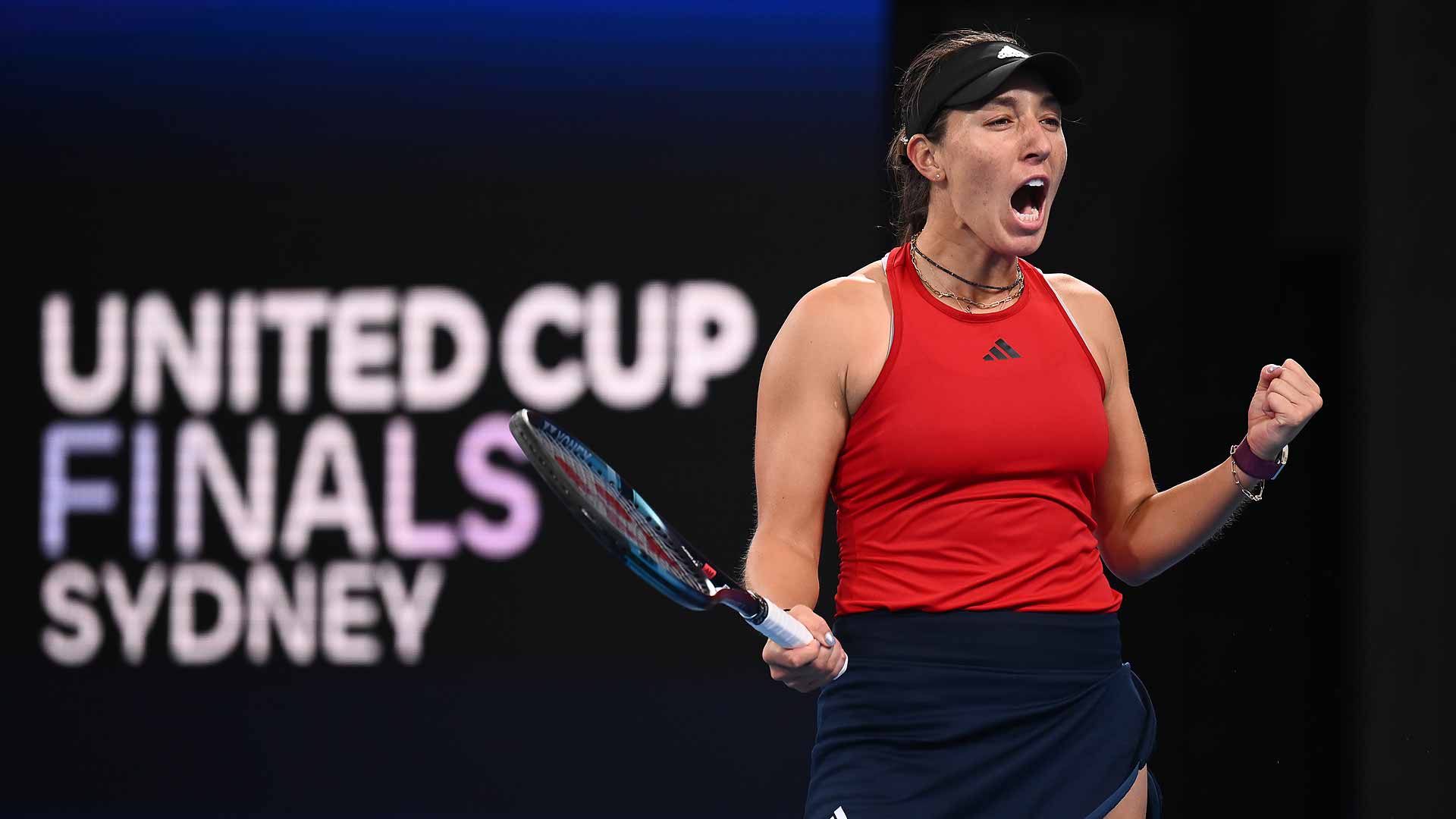
On Sunday in Sydney, the champions of the inaugural United Cup will be decided.
In the semifinals, the United States completed a clean sweep of Poland on Saturday, while Italy defeated Greece 4-1 despite Matteo Berrettini’s loss to Stefanos Tsitsipas in an excellent three-setter. Sunday’s play will feature four singles matches and a mixed doubles contest, with the first nation to win three matches to be crowned the United Cup champions.
Each day, this preview will analyze the two most prominent matches on the schedule. Sunday’s play gets underway at 1:00pm local time.
Jessica Pegula [USA] vs. Martina Trevisan [ITA] – Starts at 1:00pm
This will be the first match of the day. Pegula has gone 3-1 at this event, losing to Petra Kvitova in her first match, but defeating World No.1 Iga Swiatek on Friday. Trevisan is 2-2, though she helped propel Italy into this final with an epic victory over Maria Sakkari on Friday.
In their first career meeting, Jessica is a significant favorite. Pegula was 42-21 last season, reaching a career-high of ranking of No.3 thanks to her consistency at big events. And the fast-playing hard courts strongly favor her game, as they helped her reverse her lopsided rivalry with Swiatek in dominating fashion. By contrast, Trevisan had a losing record on hard courts last season, claiming just six tour-level matches in main draws on this surface.
The second match of the day will feature Frances Tiafoe taking on Lorenzo Musetti. Both men are 4-0 to this stage, and this matchup feels like it could easily go either way.
Taylor Fritz [USA] vs. Matteo Berrettini [ITA] – Not Before 5:30pm
This will be the third match of the day. Both players are 3-1 thus far at this event. Fritz’s loss came to Cam Norrie in the city finals, while Berrettini’s loss came in Saturday evening’s semifinals to Stefanos Tsitsipas. Notably, Matteo spent about an hour longer on court Saturday than Taylor, with the Italian’s match ending much later in the day.
Fritz is 2-0 against Berrettini. His victories came four years ago in Davis Cup on an indoor hard court, and two years ago at Indian Wells on in outdoor hard court. Taylor should be the fresher player on Sunday, and with the decided edge in their head-to-head, the American is the favorite to prevail.
The fourth match of the day sees Madison Keys take on Lucia Bronzetti, with Keys heavily favored. And the mixed doubles at the end of the day is scheduled to feature Pegula and Fritz against Trevisan and Berrettini. Overall, the United States is the favorite to win the first-ever United Cup.
The United Cup daily schedule is here.

Paris Olympics Daily Preview: Osaka Plays Kerber, Nadal Teams with Alcaraz

Tennis At The 2024 Paris Olympics: Five Things You Need To Know

Rafael Nadal’s Double Olympic Bid In Doubt, Confirms Coach Moya

Matteo Berrettini extends his winning streak to eight consecutive matches to reach the semifinal in Kitzbuehl

Novak Djokovic’s Potential Second Round Clash With Rafael Nadal Headlines Olympics Draw

Wimbledon Says No To Euros, No To Sunday Starts But Yes To An Andy Murray Statue

Wimbledon: Frances Tiafoe – ‘I Was Losing To Clowns And Took The Game For Granted’

Andrey Rublev Explains On-Court Outburst Following Wimbledon Exit

EXCLUSIVE: Sumit Nagal Brings Indian Tennis To The Main Stage But He Has Concerns About The Future

(VIDEO) Jannik Sinner Set To Renew Rivalry With Defending Champion Alcaraz, Djokovic Ready To Play

(VIDEO) What Is Wrong With Jannik Sinner?

(VIDEO) Ubaldo And Steve Flink – “Djokovic Was Too Flat, Alcaraz Triumphs Yet Again At Wimbledon”

(VIDEO) Steve Flink, Ubaldo On The Wimbledon Women’s Final: ‘The Better Player Won But Did Inexperience Play A Part?’

(VIDEO) Ubaldo And Steve: “Paolini’s Resilience Earns Her Another Stunning Grand Slam Final”

(VIDEO) Amazing Lorenzo Musetti Sets Up Djokovic Showdown At Wimbledon
Trending
-

 Hot Topics3 days ago
Hot Topics3 days agoNo Olympic Village Stay For Novak Djokovic In Paris, Says Delegation
-

 Latest news3 days ago
Latest news3 days agoWorld No.634 Laura Samson Reaches First WTA Quarter-Final At 16
-

 Hot Topics2 days ago
Hot Topics2 days ago(VIDEO) What Is Wrong With Jannik Sinner?
-

 Hot Topics3 days ago
Hot Topics3 days agoFive Talking Points Ahead Of The 2024 Olympic Men’s Tennis Tournament
-

 Focus2 days ago
Focus2 days agoJannik Sinner Withdraws From Olympics Due To Tonsillitis
-

 Focus2 days ago
Focus2 days agoMatteo Berrettini battles past Alejandro Tabilo to reach the quarter final in Kitzbuehl
-

 Focus2 days ago
Focus2 days agoCoco Gauff ‘Proud’ Of Being Named Olympic Flagbearer alongside Lebron James
-

 Hot Topics2 days ago
Hot Topics2 days agoAndy Murray At Peace With Retirement Decision Ahead Of Olympic Farewell

